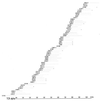Sequence-tagged connectors: a sequence approach to mapping and scanning the human genome
- PMID: 10449764
- PMCID: PMC22280
- DOI: 10.1073/pnas.96.17.9739
Sequence-tagged connectors: a sequence approach to mapping and scanning the human genome
Abstract
The sequence-tagged connector (STC) strategy proposes to generate sequence tags densely scattered (every 3.3 kilobases) across the human genome by arraying 450,000 bacterial artificial chromosomes (BACs) with randomly cleaved inserts, sequencing both ends of each, and preparing a restriction enzyme fingerprint of each. The STC resource, containing end sequences, fingerprints, and arrayed BACs, creates a map where the interrelationships of the individual BAC clones are resolved through their STCs as overlapping BAC clones are sequenced. Once a seed or initiation BAC clone is sequenced, the minimum overlapping 5' and 3' BAC clones can be identified computationally and sequenced. By reiterating this "sequence-then-map by computer analysis against the STC database" strategy, a minimum tiling path of clones can be sequenced at a rate that is primarily limited by the sequencing throughput of individual genome centers. As of February 1999, we had deposited, together with The Institute for Genomic Research (TIGR), into GenBank 314,000 STCs ( approximately 135 megabases), or 4.5% of human genomic DNA. This genome survey reveals numerous genes, genome-wide repeats, simple sequence repeats (potential genetic markers), and CpG islands (potential gene initiation sites). It also illustrates the power of the STC strategy for creating minimum tiling paths of BAC clones for large-scale genomic sequencing. Because the STC resource permits the easy integration of genetic, physical, gene, and sequence maps for chromosomes, it will be a powerful tool for the initial analysis of the human genome and other complex genomes.
Figures


Similar articles
-
Analysis of sequence-tagged-connector strategies for DNA sequencing.Genome Res. 1999 Mar;9(3):297-307. Genome Res. 1999. PMID: 10077536 Free PMC article.
-
Analysis and mapping of randomly chosen bacterial artificial chromosome clones from hexaploid bread wheat.Proc Natl Acad Sci U S A. 2005 Dec 27;102(52):19243-8. doi: 10.1073/pnas.0509473102. Epub 2005 Dec 15. Proc Natl Acad Sci U S A. 2005. PMID: 16357197 Free PMC article.
-
A marker-dense physical map of the Bradyrhizobium japonicum genome.Genome Res. 2001 Aug;11(8):1434-40. doi: 10.1101/gr.185001. Genome Res. 2001. PMID: 11483585 Free PMC article.
-
Integration of cytogenetic data with genome maps and available probes: present status and future promise.Semin Hematol. 2000 Oct;37(4):420-8. doi: 10.1016/s0037-1963(00)90021-0. Semin Hematol. 2000. PMID: 11071363 Review.
-
Genome mapping: cDNA approaches.Curr Opin Genet Dev. 1992 Jun;2(3):412-6. doi: 10.1016/s0959-437x(05)80151-0. Curr Opin Genet Dev. 1992. PMID: 1504615 Review.
Cited by
-
Advances in BAC-based physical mapping and map integration strategies in plants.J Biomed Biotechnol. 2012;2012:184854. doi: 10.1155/2012/184854. Epub 2012 Feb 27. J Biomed Biotechnol. 2012. PMID: 22500080 Free PMC article. Review.
-
Progress in understanding and sequencing the genome of Brassica rapa.Int J Plant Genomics. 2008;2008:582837. doi: 10.1155/2008/582837. Int J Plant Genomics. 2008. PMID: 18288250 Free PMC article.
-
Generation of physical map contig-specific sequences.Front Genet. 2014 Jul 22;5:243. doi: 10.3389/fgene.2014.00243. eCollection 2014. Front Genet. 2014. PMID: 25101119 Free PMC article. Review.
-
A sea urchin genome project: sequence scan, virtual map, and additional resources.Proc Natl Acad Sci U S A. 2000 Aug 15;97(17):9514-8. doi: 10.1073/pnas.160261897. Proc Natl Acad Sci U S A. 2000. PMID: 10920195 Free PMC article.
-
Construction of a nurse shark (Ginglymostoma cirratum) bacterial artificial chromosome (BAC) library and a preliminary genome survey.BMC Genomics. 2006 May 3;7:106. doi: 10.1186/1471-2164-7-106. BMC Genomics. 2006. PMID: 16672057 Free PMC article.
References
-
- Green E D, Olson M V. Science. 1990;250:94–98. - PubMed
-
- Green E D, Mohr R M, Idol J R, Jones M, Buckingham J M, Deaven L L, Moyzis R K, Olson M V. Genomics. 1991;11:548–564. - PubMed
-
- Kere J, Nagaraja R, Mumm S, Ciccodicola A, D’Urso M, Schlessinger D. Genomics. 1992;14:241–248. - PubMed
-
- Green E D, Green P. PCR Methods Appl. 1991;1:77–90. - PubMed
-
- Boysen C, Carlson C, Hood E, Hood L, Nickerson D A. Immunogentics. 1996;44:121–127. - PubMed
Publication types
MeSH terms
Associated data
- Actions
- Actions
- Actions
- Actions
- Actions
- Actions
- Actions
- Actions
- Actions
- Actions
- Actions
- Actions
- Actions
- Actions
- Actions
- Actions
- Actions
- Actions
- Actions
- Actions
- Actions
- Actions
- Actions
- Actions
- Actions
- Actions
- Actions
- Actions
- Actions
- Actions
LinkOut - more resources
Full Text Sources
Other Literature Sources
Research Materials

